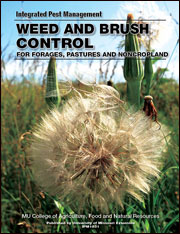Editor's note
The following abstract describes a publication that is only available for purchase.
For an idea of the information you’ll find in this publication, take a peek inside at the musk thistle entry (PDF).
Errata: In Table 1 on page 156, the response of ironweed to Remedy Ultra is E.
Annual broadleaf and grass weeds can become a serious problem in pastures and forages unless proper weed management is practiced. This publication, based on University of Missouri research, is a guide for identifying weeds and selecting and comparing herbicides. It is written specifically for the forage crops, soils and weed problems in Missouri. Color photos of 75 weeds in various stages of development are included to aid in weed identification. Five tables provide details on weed response to herbicides, herbicides currently labeled for control of various weeds, and crop replant restrictions.
Topics
- Amur honeysuckle (Lonicera maackii)
- Annual marshelder (Iva annua)
- Areas for use of noncropland herbicides for woody plant control
- Arrowleaf sida (Sida rhombifolia)
- Biennial broadleaf weeds
- Bindweed, field (Convolvulus arvensis)
- Bindweed, hedge (Calystegia sepium)
- Bitter sneezeweed (Helenium amarum)
- Black locust (Robinia pseudoacacia)
- Blackberries (Rubus spp.)
- Broadleaf weed control in tall fescue pastures and haylands
- Buffalobur (Solanum rostratum)
- Burdock, common (Arctium minus)
- Buttercup, bulbous (Ranunculus bulbosus)
- Chicory (Cichorium intybus)
- Cinquefoil, sulfur (Potentilla recta)
- Common cocklebur (Xanthium strumarium)
- Common mullein (Verbascum thapsus)
- Common pokeweed (Phytolacca americana)
- Common yarrow (Achillea millefolium)
- Coralberry (Symphoricarpos orbiculatus)
- Crop replant restrictions for pasture herbicides
- Dandelion (Taraxacum officinale)
- Dewberry (Rubus flagellaris)
- Dock, broadleaf (Rumex obtusifolius)
- Dock, curly (Rumex crispus)
- Eastern black nightshade (Solanum ptycanthum)
- Eastern red cedar (Juniperus virginiana)
- Garlic mustard (Allaria petiolata)
- Goldenrods (Solidago spp.)
- Greenbriers (Smilax spp.)
- Groundcherry, smooth (Physalis longifolia)
- Hedge mustard (Sisymbrium officinale)
- Hemp dogbane (Apocynum cannabinum)
- Honey locust (Gleditsia triacanthos)
- Horsenettle (Solanum carolinense)
- Ironweeds (Vernonia spp.)
- Japanese hop (Humulus japonicas)
- Jimsonweed (Datura stramonium)
- Knapweed, spotted (Centaurea stoebe)
- Knotweed, Japanese (Polygonum cuspidatum)
- Late boneset (Eupatorium serotinum)
- Maypop passionflower (Passiflora incarnata)
- Milkweed, common (Asclepias syriaca)
- Morningglory, bigroot (Ipomoea pandurata)
- Mugwort (Artemisia vulgaris)
- Multiflora rose (Rosa multiflora)
- Noncropland herbicides
- Olive, autumn (Elaeagnus umbellata)
- Olive, Russian (Elaeagnus angustifolia)
- Osage orange (Maclura pomifera)
- Perennial broadleaf weeds
- Perilla mint (Perilla frutescens)
- Pilewort (Erechtites hieracifolia)
- Plantain, broadleaf (Plantago major)
- Plantain, buckhorn (Plantago lanceolata)
- Poison hemlock (Conium maculatum)
- Poison ivy (Toxicodendron radicans)
- Prickly pear (Opuntia humifusa)
- Prostrate knotweed (Polygonum aviculare)
- Ragweed, common (Ambrosia artemisiifolia)
- Ragweed, giant (Ambrosia trifida)
- Ragweed, lanceleaf (Ambrosia bidentata)
- Red sorrel (Rumex acetosella)
- Response to herbicides
- Sericea lespedeza (Lespedeza cuneata)
- Snow-on-the-mountain (Euphorbia marginata)
- Spiny amaranth (Amaranthus spinosus)
- Spurge, nodding (Chamaesyce nutans)
- Summer annual broadleaf weeds
- Thistle, bull (Cirsium vulgare)
- Thistle, Canada (Cirsium arvense)
- Thistle, musk (Carduus nutans)
- Thistle, tall (Cirsium altissimum)
- Tick trefoils (Desmodium spp.)
- Trumpetcreeper (Campsis radicans)
- Vervains (Verbena spp.)
- Weed response to herbicides
- Western salsify (Tragopogoon dubius)
- Wild carrot (Daucus carota)
- Wild indigos (Baptisia spp.)
- Wild parsnip (Pastinaca sativa)
- Wingstem (Verbesina alternifolia)
- Woody shrubs, vines and brush species
- Woolly croton (Croton capitatus)
Pages
- 164
